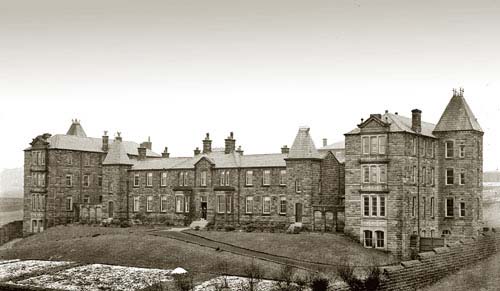Gruelling Experiences - in the workhouse
Hebden Bridge History Society meeting report.
Speaker: Peter Higginbotham
Monday, 16 March 2015
We probably all have an image of workhouse life and how the inmates subsisted on weak gruel, but Peter Higginbotham's exhaustive researches reveal a far more complex and fascinating story, as he told Hebden Bridge Local History Society.
From the age of Elizabeth I, each parish was responsible for providing help for those inhabitants who found themselves destitute. A poor-rate was collected to fund the relief, and the able-bodied were expected to work in exchange for help. For some parishes this forced work was best undertaken in a house, where those unable to work could also be sheltered. These workhouse grew in number through the 18th century and reminders can still be found locally – at Workhouse Farm and Workhouse Green in Colden for example.

Stansfield View
The more formidable workhouses of popular imagination were built as a result of the 1834 Poor Law Act, which established Poor Law Unions covering a much wider area than the old parishes. 'Out-relief' was abolished and the workhouses were to act as a deterrent to anyone claiming relief. Although this was popular among the ratepayers of the south, in the northern manufacturing areas it was seen as an unnecessary expense. Todmorden in particular stood out against the proposal for forty years until eventually building a workhouse at Mankinholes - Stansfield View.
The workhouses were strictly regulated: no-one was forced to enter, but whole families had to be admitted together. Once inside, the inmates were classified and strictly segregated – males and females never mixed, and children beyond infancy were housed separately and perhaps saw a parent on Sundays. As the name suggests, the regime involved work - mainly domestic for the women, and physical labour for the men, such as breaking stones for road-making.
The elderly and infirm were not required to work. All the inmates wore a uniform, and meals were also regulated - mainly gruel, bread and cheese with meat or bacon twice a week.
Research has shown that many of the residents were single parents and their children as well as elderly men beyond useful work and the so-called 'imbeciles' and 'idiots' who could not fend for themselves. Bit by bit the workhouse hospitals, at first staffed by mostly illiterate inmates who got drunk on the various medicines, became a more reliable source of treatment for the sick.
By 1930 the workhouses were rebranded as Public Assistance Institutes and control passed to local councils, and eventually their role was taken over by the NHS and welfare state.
The old workhouses were perhaps not essentially cruel, but the shame and stigma of being sent to the workhouse never disappeared. There is a wealth of stories still to be discovered, with records in national and local archives as well as on Peter's own website www.workhouses.org.uk and in his splendid collection of books.
The final meeting of the Hebden Bridge Local History Society will be on Wednesday March 25th, when Dave Smalley will speak about 'The dam that isn't and the great floating plug of Colden'. Meetings start at 7.30 at the Methodist Hall, and all are welcome. Details on the website www.hebdenbridgehistory.org.uk
With thanks to Sheila Graham for this report
Previously, on the HebWeb
Pre-History on our hill tops (9 March 2015)
Growing up in Sowerby (16 February 2015)
Patterns in the Landscape: the evolution of settlement and enclosure in the Upper Calder Valley (5 February 2015)
Wakefield Court Rolls for Family History: Sylvia Thomas (18 Jan 2015)
Happy Birthday Stoodley Pike: by Nick Wilding (16 Dec 2014)
Wills, Inventories and Economic Activity in the Parish of Halifax at the end of the 17th Century: Alan Petford (30 Nov 2014)
Local History Society Archive explored - Following the 65th AGM, members of Hebden Bridge Local History Society were treated to a sample of some of the treasures to be found in the Society's archive. (19 Nov 2014)
Views from two communities on the outbreak of war in 1914 - Mike Crawford, Wolfgang Hombach and Nick Wilding (27 Oct 2014)
The Listed Buildings of the Hebden Bridge area with Peter Thornborrow. (14 Oct 2014)
Valley of a Hundred Chapels by Amy Binns (29 Sept 2014)
History Group Study Day report: Power and Potability (11 Sept 2014)
Whose land is it anyway? How parliamentary enclosure shaped the landscape of the Calder Valley: speaker, Sheila Graham. Read more (6 April 2014)
Yorkshire Life between the Wars: speaker, Ian Dewhirst. Read more (20 March 2014)
Industrialisation and the Calder Valley: Communities in a unique landscape - Talk by Dr Stephen Caunce Read more (3 March 2014)
Quarrying in Calderdale: George Bowers gave a talk on the history of stone quarries in our local area. Read more (15 Feb)
Calder Valley Buildings of the Seventeenth Century: the craftsmen and their patrons Read more (27 Jan)See Small Ads (12 March)
Some thoughts on historic buildings and their repairs by Alan Gardner
More history reports in the HebWeb History Section

